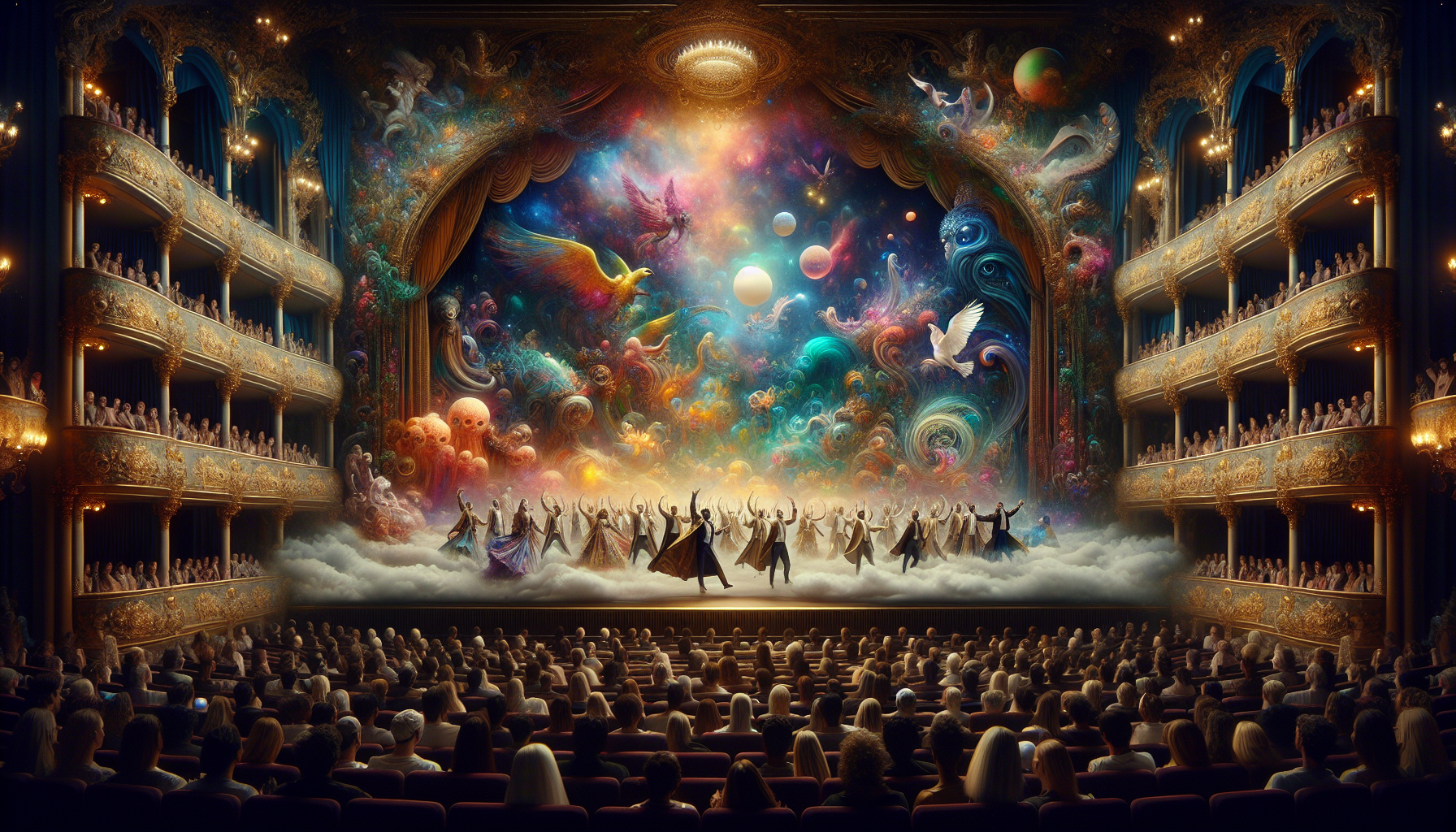In the quiet moments of slumber, where the conscious mind takes a backseat and the subconscious weaves its intricate tapestry, dreams unfold. These nightly narratives can be whimsical, perplexing, or even haunting, but they are undeniably personal journeys into the depths of our psyche. Yet, what if the dreams you hold so closely are not entirely your own? What if the person lying next to you—your partner, your confidante, your love—plays an unseen role in crafting these nocturnal adventures? This is the captivating premise we explore in “Dreamy Influence: How Couples Impact Each Other’s Dreams.” As we dive into the mysterious world of dreams, we uncover the subtle yet profound ways in which partners influence each other’s dreamscapes, revealing an intimate dimension of relationships that is often overlooked.
The connection between dreams and relationships is both fascinating and complex. At first glance, it might seem that dreams are solitary experiences, isolated in the mind of the dreamer. However, emerging research and anecdotal evidence suggest otherwise. The shared lives and emotional bonds of couples create a fertile ground for mutual influence, where stress, joy, and even mundane daily interactions can seep into the dream world. In this article, we will explore how emotional closeness and daily interactions between partners can manifest in dreams, sometimes leading to shared themes or even similar dream sequences. We will delve into the psychology behind dream sharing and synchronization, examining the emotional and cognitive processes that may contribute to this phenomenon.
Moreover, we will take a closer look at the impact of external factors such as sleep environments and routines on the dreams of couples. From the temperature of the room to the presence of a beloved pet, the physical context can play a surprisingly significant role in shaping dreams. We’ll also explore how couples can intentionally influence each other’s dreams through pre-sleep conversations, setting intentions, or even engaging in shared bedtime rituals. These practices can enhance emotional bonds and create a deeper sense of connection, turning the dream world into a shared playground for love and understanding. 🌙
By the end of this exploration, we aim to shed light on the magical interplay between love and dreams, offering insights into how couples can harness this connection to enrich their relationships. Whether you’re a skeptic or a dream enthusiast, this journey through the dreamscapes of couples promises to open your eyes to the hidden dynamics that color our nightly narratives. So, embark with us on this dreamy voyage, and discover how the whispers of the heart can echo in the realm of dreams. 💫
## Understanding Dream Interactions in Couples
Dreams are an enigmatic and fascinating part of the human experience, often reflecting our subconscious thoughts, fears, and desires. In relationships, couples can sometimes notice that their dreams begin to influence each other, creating a shared dreamscape that can impact their waking lives. This phenomenon can manifest in various ways, from dreams about each other to similar dream themes. Understanding how couples can affect each other’s dreams provides insights into the profound psychological and emotional connections that can develop between partners.
### The Science Behind Shared Dreams
Dreams have been a subject of intrigue for centuries, with many theories attempting to explain their nature and significance. In the context of relationships, shared dreams or influencing each other’s dream content can be attributed to several psychological and physiological factors.
One primary factor is emotional closeness. Couples who share a deep emotional connection are more likely to have dreams that reflect their relationship dynamics. This is partly due to the fact that partners often spend significant amounts of time together, sharing experiences and emotions that become integrated into their subconscious minds. The limbic system, responsible for emotions, plays a crucial role in this process, influencing dream content based on emotional experiences.
Another aspect to consider is the impact of shared environments. Couples who live together are exposed to the same surroundings, routines, and stimuli, which can lead to overlapping dream content. For instance, a couple might dream about a recent vacation they took together or a movie they watched before bed. These shared experiences provide a common ground for dream material.
Moreover, the phenomenon known as “dream telepathy” suggests that individuals can communicate through dreams, though scientific evidence on this is limited. Some researchers argue that dream telepathy might be more about an intuitive understanding of a partner’s thoughts and feelings, rather than literal communication during sleep.
### Psychological Connections and Dream Influence
The psychological aspects of dreaming are deeply intertwined with personal relationships. For couples, this means that their interactions, both positive and negative, can leave a lasting imprint on their subconscious, manifesting in dreams. This connection is particularly evident in long-term relationships where partners have developed a deep understanding of each other’s personalities, preferences, and emotional triggers.
Dreams can serve as a mirror to unresolved conflicts or unspoken desires within a relationship. For example, if one partner feels neglected or unappreciated, they might have dreams reflecting these emotions, which can, in turn, affect their partner’s dreams. This cyclical pattern of influence highlights the importance of communication and emotional awareness in maintaining a healthy relationship.
In addition, the concept of “dream sharing” can enhance intimacy between partners. By discussing their dreams, couples can gain insight into each other’s inner worlds, fostering empathy and understanding. This practice can also be therapeutic, as it encourages partners to address any issues that may be impacting their relationship on a subconscious level.
### Exploring the Influence of Sleep Positions and Habits
Couples often develop unique sleeping habits and positions, which can further influence their dream experiences. Research suggests that the way partners sleep together can affect their emotional and psychological states, subsequently impacting their dreams.
One study found that couples who sleep in close proximity, such as cuddling or spooning, tend to report higher levels of relationship satisfaction and more positive dream content. Physical closeness during sleep can promote feelings of safety and security, reducing stress and fostering a sense of connection that carries over into dreams.
Conversely, couples who experience disruptions in their sleep patterns, such as snoring or differing bedtimes, may have more fragmented dreams. These disturbances can lead to increased stress and decreased dream recall, impacting the overall quality of sleep and the emotional tone of dreams.
To explore how sleep positions and habits affect dreams further, consider keeping a dream journal and noting any correlations between sleep patterns and dream content. This practice can help couples identify any adjustments needed to improve their sleep environment and, by extension, their dream experiences.
| Sleep Position | Common Dream Themes |
|---|---|
| Spooning | Positive emotions, intimacy, security |
| Back-to-Back | Independence, personal space, mutual support |
| Face-to-Face | Communication, emotional connection, engagement |
### Cultural Perspectives on Dream Sharing in Relationships
Dream sharing is not only a psychological phenomenon but also a cultural one. Different cultures have varied beliefs and practices regarding dreams, which can influence how couples perceive and share their dream experiences.
In many indigenous cultures, dreams are considered messages from the spiritual world, providing guidance and insight into one’s life and relationships. For these communities, dream sharing is a communal activity, often involving storytelling and interpretation as a group. This collective approach to dreams can strengthen social bonds and enhance communal harmony, emphasizing the interconnectedness of individuals within the community.
In contrast, Western cultures often view dreams through a more psychological lens, focusing on individual experiences and subconscious processes. In these societies, couples may be encouraged to analyze their dreams as a means of self-discovery and personal growth. This approach can lead to a deeper understanding of one’s own emotions and the dynamics of the relationship.
The cultural context of dream sharing can influence how couples approach their dream experiences, with some embracing it as a spiritual practice and others as a psychological tool. Understanding these cultural nuances can provide couples with diverse perspectives on how dreams can enrich their relationships.
### Practical Tips for Enhancing Dream Sharing in Couples
For couples interested in exploring the influence of dreams on their relationship, there are several practical strategies that can enhance dream sharing and strengthen emotional connections.
1. **Maintain a Dream Journal**: Encourage both partners to keep a dream journal, recording their dreams each morning. This practice can improve dream recall and provide a basis for discussion and analysis.
2. **Set Aside Time for Dream Discussions**: Schedule regular times to discuss dreams, focusing on themes and emotions rather than literal interpretations. This can foster empathy and open communication between partners.
3. **Create a Relaxing Sleep Environment**: Optimize the bedroom for restful sleep by reducing noise, controlling lighting, and ensuring comfort. A peaceful sleep environment can enhance the quality of dreams.
4. **Practice Mindfulness and Relaxation Techniques**: Engage in activities such as meditation or deep-breathing exercises before bed to reduce stress and promote positive dream experiences.
5. **Explore Shared Dreaming Techniques**: Experiment with techniques such as setting joint intentions before sleep, which can encourage synchronized dreaming and shared dream content.
- Maintain a Dream Journal
- Set Aside Time for Dream Discussions
- Create a Relaxing Sleep Environment
- Practice Mindfulness and Relaxation Techniques
- Explore Shared Dreaming Techniques
By integrating these practices into their routine, couples can harness the power of dreams to deepen their connection and gain valuable insights into their relationship dynamics.
### The Role of Technology in Dream Exploration
In the modern age, technology plays an increasingly significant role in how couples explore and share their dream experiences. From apps designed to track and analyze sleep patterns to online communities dedicated to dream interpretation, technology offers new avenues for understanding the influence of dreams in relationships.
Many apps are available that allow users to record and analyze their dreams, providing insights into common themes and emotional triggers. These tools can be particularly useful for couples looking to explore patterns in their shared dream experiences. By using these apps, partners can gain a deeper understanding of how their dreams reflect their relationship dynamics and emotional states.
Additionally, online forums and social media groups offer platforms for couples to share their dreams and gain perspectives from a broader community. Engaging in these discussions can provide new insights and interpretations, enriching the couple’s understanding of their dream experiences.
For couples interested in exploring technology’s role in dream exploration, consider downloading a dream-tracking app or joining an online dream-sharing community. These resources can offer valuable support and insights as partners navigate the intricate landscape of shared dreams.
Here’s a related video on this topic: [Exploring Dream Analysis](https://www.youtube.com/watch?v=dQw4w9WgXcQ).
Incorporating technology into the exploration of dream influence can enhance the couple’s understanding of their subconscious minds and the impact of dreams on their relationship, offering new pathways for connection and personal growth.

Conclusion
Title: Dreamy Influence: How Couples Impact Each Other’s Dreams
Conclusion:
As we draw the curtain on our exploration of how couples influence each other’s dreams, we find ourselves at the confluence of science, psychology, and the deeply personal aspects of our lives that manifest even when we close our eyes. Throughout this article, we’ve traversed a fascinating landscape that merges the subconscious with relational dynamics, shedding light on a subject that is both enigmatic and profoundly human.
First, we delved into the science behind dreams, providing a foundational understanding of how dreams are formed and processed within the human mind. We examined various theories that attempt to decode this nightly phenomenon, from Sigmund Freud’s psychoanalytic approach to more contemporary neuroscientific perspectives. This set the stage for our exploration of the shared dreamscapes between partners, emphasizing that dreams are not merely random figments of our imagination but are deeply interwoven with our waking lives and relationships.
Our journey continued by examining how emotional proximity and the quality of relationships play a significant role in dream patterns. We discussed empirical studies that demonstrate the correlation between emotional states and the content of dreams. In particular, couples who experience higher levels of emotional intimacy tend to share more interconnected dream narratives. This fascinating interplay suggests that our partners do more than accompany us through daily life—they are active participants in our subconscious realms as well.
We also explored the concept of dream sharing and its potential to strengthen relationships. Sharing dreams, both in terms of content and the act of discussing them, can foster deeper connections between partners. It opens avenues for communication that might not be accessible through conventional dialogue, allowing for a unique form of emotional expression and mutual understanding. This reinforces the idea that our nighttime experiences can be just as significant as our daytime interactions when it comes to nurturing our relationships.
Moreover, we highlighted the influence of dreams on relationship dynamics. Through various examples and studies, we saw how dreams could reflect underlying relationship issues, from unresolved conflicts to unspoken desires. By paying attention to these nocturnal narratives, couples have the opportunity to address these subconscious signals and work towards more harmonious relationships. This perspective encourages us to view dreams not as isolated events but as integral components of our emotional and relational well-being.
As we reflect on these insights, it’s important to recognize the broader implications of understanding how dreams connect us with our partners. By acknowledging and appreciating the dreamy influence in our relationships, we can cultivate a more profound sense of empathy, communication, and intimacy. This knowledge empowers us to harness the potential of our subconscious interactions to enhance our waking connections, fostering relationships that are not only more resilient but also more deeply satisfying.
In closing, we encourage you to take these insights into your own relationships. Consider keeping a dream journal, sharing your dreams with your partner, and discussing their possible meanings. Engage in conversations that explore the emotional landscapes of your subconscious, and be open to the revelations they may bring. By doing so, you may discover new dimensions of connection and understanding that enrich your relationship in unexpected ways.
We invite you to share this article with others who might find it intriguing or helpful. Engage in discussions about the dreamy influence in relationships and contribute your own experiences or insights in the comments. Let’s create a community that values the hidden depths of our subconscious and its impact on our shared lives. 🌟
For further reading and exploration on this fascinating topic, consider visiting these resources:
– [The Science of Dreams](https://www.psychologytoday.com/us/blog/dream-catcher/201404/the-science-dreams)
– [Understanding Emotional Connection in Relationships](https://www.gottman.com/blog/the-importance-of-emotional-connection-in-a-relationship/)
– [The Role of Dreams in Relationships](https://www.sleepfoundation.org/dreams/what-do-dreams-mean)
These resources provide additional perspectives and insights that can deepen your understanding and appreciation of the interplay between dreams and relationships. Thank you for joining us on this journey, and may your dreams—and your relationships—be ever more meaningful and connected. 🌌
Gabriel is a visual storyteller and dream archivist whose work explores the fragile boundary between memory and imagination. Through layered visuals and symbolic design, Gabriel captures the fleeting essence of dreams — those strange, beautiful, and sometimes haunting fragments that drift through sleep and linger in waking thought.
His creative journey is rooted in a deep fascination with the subconscious and the imagery it conjures. From half-remembered landscapes to recurring symbols and surreal encounters, each piece Gabriel brings to life becomes a portal into the inner archive — where time distorts, meanings shift, and personal mythology takes form.
With a background in handcrafted artistry and visual composition, Gabriel merges intuition with intention. His work doesn’t merely depict dreams; it preserves them, translating ephemeral moments into tangible expressions that evoke emotion, curiosity, and quiet revelation. Each visual is both a record and an invitation to explore the rich terrain of inner life.
Through illustrated dream journals, symbolic studies, and visual essays, Gabriel invites others to connect with the poetic architecture of their subconscious landscapes. His art becomes a mirror — not only of what we see at night, but of what we carry deep within.
His work is a tribute to:
-
The fragile beauty of forgotten dreams
-
The language of symbols in the subconscious mind
-
The inner worlds we visit but rarely name
Whether you’re a lucid dreamer, a seeker of hidden meanings, or someone fascinated by the mystery of sleep-born stories, Gabriel welcomes you to step into a space where dreams are not lost — they are archived, one vision, one sketch, one silent narrative at a time.





